Rolex Middle Sea Race 2009
Last week Myles and I went to Malta to race on Hooligan VI a Farr 40 in the Rolex Middle Sea Race. Although we did not win the race or actually do that well we did finish which is better than 30 or so other boats and we had an interesting race.
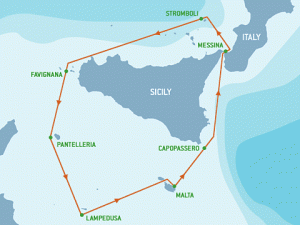
The course is 605 miles or so long but with the beating legs that of course makes the course longer. It takes you from Malta up to Sicily and around the north side and then around several islands including the active volcano of Stromboli returning to Malta. Interestingly you get very close to the Libyan waters and can see the glow of Libya in the night. You also go past Mt Etna on Sicily – who knew that it was snow capped!
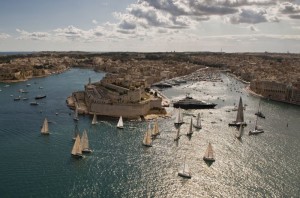
Photo credit: Rolex / Kurt Arrigo
The start and finish is in the Harbor with the start in Grand Harbor under the shadow of Fort Elmo and the Venice like city of Valletta (the city planned and built 450 years ago by the Knights of the Order of St John). The starting gun was not diminutive in fact it was a massive signal cannon which is traditionally fired at midday. There was a crowd lining the curtain walls of Valletta and Vittisoria (one of the three cities) the most people I have ever seen interested in a yacht race with the small boats starting first in a light breeze.
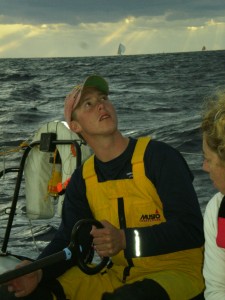
The weather during the race was varied we saw 2-42 knots and there were races within the race which if you were able to shift gears quickly meant you did well. At night the combination of the cold northerlies and the very warm sea water created an environment for squalls, water spouts and large thunderheads. These were incredibly hard to see or anticipate as there was no moon. The squalls hit fast and hard so it was necessary to become very fast and at throwing reefs in and out and taking down spinnakers as the wind direction would shift dramatically. These micro systems brought hail (I am not kidding) and rain that stung on impact making it hard to see. The nights were extremely long with 13 hours of darkness putting an emphasis on organization for the night period like the necessity to tag reef lines in and out – reef one to reef three etc.
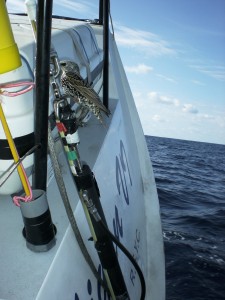
At one point the number one reef line came out of the boom entirely luckily when the sun came up there was 10 knots of wind so we were able to tag out the second reef and use it to tag in both reefs. It did necessity the removal of the sheaves in the aft of the boom which with a cat’s cradle of line we were able to do without dropping the main but required quite a lot of balancing. Once that was repaired we started to become competitive about how quickly we could throw reefs in and out with 3 or 4 people on deck. The best time was around 1 minute which meant on our last ¼ mile to the finish inside the harbor meant we only lost ½ a boat length when it came to shaking out the reef! The hardest process is the fact that the main halyard is clutched down below on the Farr 40 so you have to rig up a block to get it up on deck to a primary winch. We ended up at night leaving it off the clutch and on a winch on deck so we could react quicker however, this left lines that people tripped over.
We had a few other gear issues including the chafing through of the cover on the jib halyard requiring Myles to go up and resolve the problem and I repaired the halyard. The main winches on a Farr 40 are under sized which puts a load onto the brass pawl housing creating ovalling and end result is the winches were back winching (not terribly safe). As a result we had to tie off one end of the sheet and cross sheet on starboard tack to the primary with the mainsheet. It is so important on a Farr 40 to be able to trim the main continuously. The speedo stopped working about 100 miles from the finish meaning the instruments basically were useless. After the speedo was removed checked and returned to the housing we had some excitement when we had an internal 4 foot waterspout after the speedo blew out – obviously it had not been put back correctly. Lots of bailing later the boat was no longer sinking!
The crew was all very nice people with 3 students taking a lot of the weight of sail changes and general running around trying to make the boat fast. Our navigator an ex merchant seaman is very English and was constantly brewing tea sometimes twice per watch – I did find it a little hard to deal with when we had four on deck and all their hands were needed but instead mugs were being clutched. I can see this is a great morale raiser in the cold English Channel conditions. I did have a chuckle when at three am upon waking for watch I was quizzed about where the teaspoon might have disappeared to as it is ‘jolly hard to make tea with a dessert spoon”! We used the boil in the bag camping food and it was not bad at all with the Hot Pot winning the trophy for the best tasting. I don’t think you want to see what it looks like though it is much better to just eat it in the darkness ?
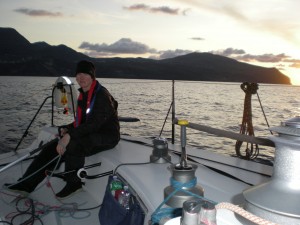
The ‘kids’ efforts combined with a 3 hour on and off watch system meant I got quite a lot of rest in comparison to the Caribbean 600! So although we did have gale force conditions they didn’t last long and life was not that uncomfortable. The boat was a lot drier than the IRC 46 however, I would have preferred to have my Kokotat drysuit as I am in love with it and don’t like getting wet.
The last 30 miles we match raced two other boats with the local Maltese knowledge helping them to gain on us dramatically on the way up the Maltese coast. The kids really got into trimming the boat constantly and with everyone on the rail the boat was sailed at a lot higher percent of its potential. Three boats finished within a minute of each other with us the middle boat doing an interesting method of tacking with two winches that didn’t work.
So all in all a fun race with amazing scenery and good company.

